






If you are a new member of the Montana State Golf Association (MSGA) this year, welcome to our Montana Golf Community. For those of you who are longtime members, thank you again for helping strengthen the game in the Treasure State.
This time of year, it’s a great swirl of activity with courses opening, tournaments and events underway and our philanthropic efforts at work. This month, the MSGA is awarding 7 scholarships to graduating seniors to help them with their educational pursuits.
2025 marks the 10th year of grantmaking to support junior golf development focused at Montana Kids grades K-8. This year, 15 communities received grant funding. Like every year, the requests are greater than our available funds. Each year, we have seen requests increase in both number and program size.
If you are interested in supporting our scholarship or grant programs, your tax-deductible gift will help ensure that we can continue to meet the needs and remain in-step with the costs of programming and higher education. To learn more about how you can make a difference, click here.
Additionally, our Annual Trip-of-the-Month Raffle will begin our next cycle of drawings in September. Tickets are available for purchase now.
Last issue, I wrote about our partnerships throughout the Montana Golf Community and beyond. When you’re at the course next time, be sure to thank a member of the grounds crew for maintaining the playgrounds we

frequent. Say thanks to a staff member or PGA Professional who may be providing a lesson or educating a new golfer.
Thanks to our incredible combination of staff and volunteers, the MSGA has been already hitting the road and will continue to crisscross the state running tournaments and visiting courses. Say hello and introduce yourself if you see the circle logo out and about!
While we don’t make it to every course, every year, I’m always encouraging questions from our membership. I’m including a few ones I’ve been posed in-person so far. Please drop us a line if you have a question or topic, you’d like us to discuss in a future issue.
Q: How many holes do I need to play before I have an “official” Handicap Index®?
A: 54. Three 18-hole rounds or five 9-hole

rounds. It’s easier than ever to get one.
Q: Why does the GHIN App get mad at me if I don’t post my score the day I played?
A: Despite my growing paranoia of AI and Robots, the GHIN App where most of our players post their scores doesn’t get “mad” at you, but rather it’s important to post your score day-of to be included in the playing conditions calculation (PCC), which is part of the handicap system. This calculation factors in scoring for the day-of to account for exceptional weather or course set up. Some days you may see higher or lower scores and your score may have a PCC adjustment.
Q: If I’m having a bad hole, what’s the most I can put down?
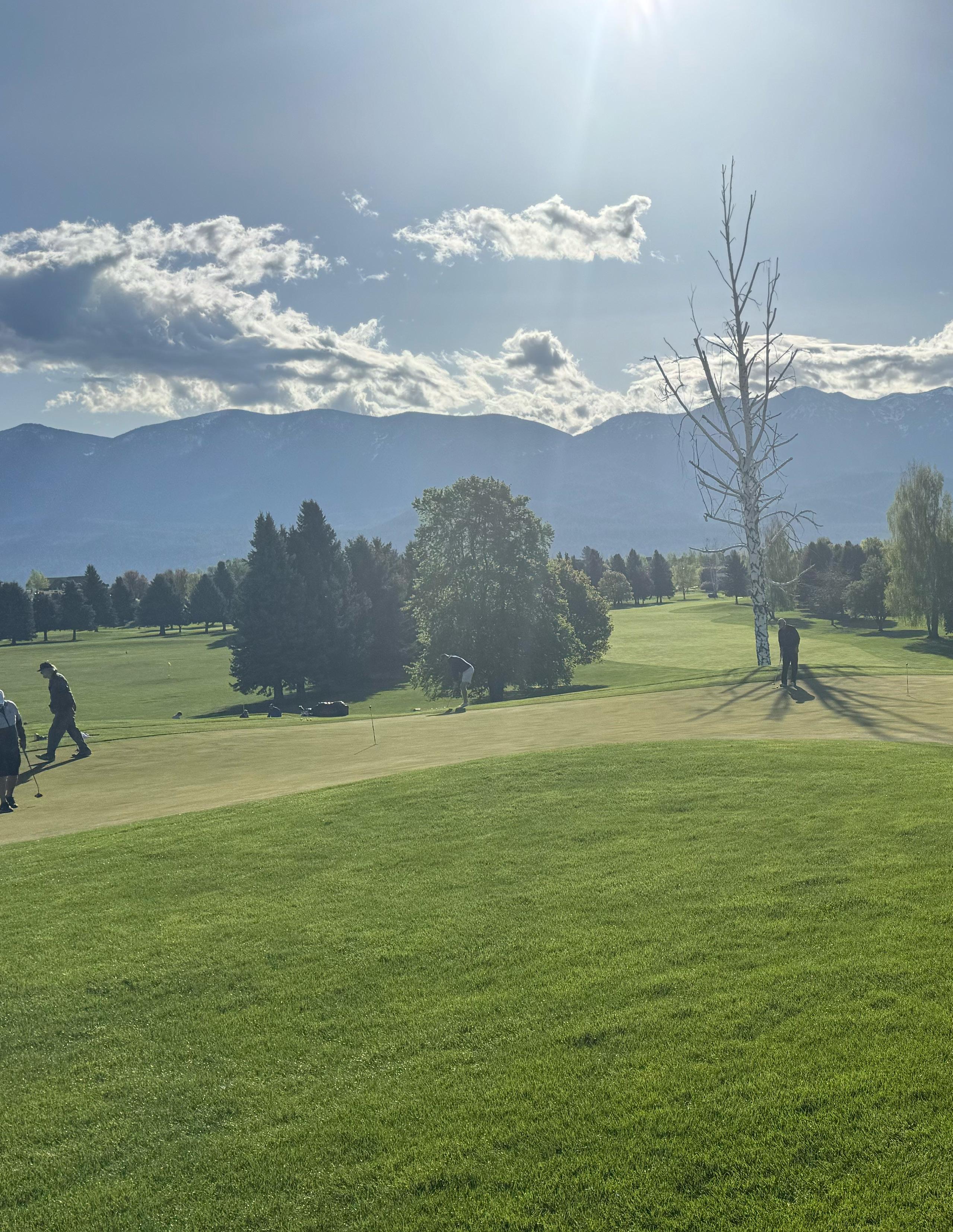
A: Net Double Bogey is the maximum allowable hole score for handicap purposes. This prevents the occasional exceptionally bad hole from impacting your Handicap Index too severely. If you post your score with hole-byhole entry on the app, it will automatically be calculated. You take the par, any stroke index shot that you would apply (commonly seen on scorecard as “handicap” 1-18) and two more.
Example: A golfer with a Handicap Index of 8 has a difficult time on hole seven, which has a stroke index of three. This par 4 +1 (stroke index) + 2 = 7. The Net Double Bogey is 7.
Note: If you’re playing in a stroke play competition, you still must hole out and record the number you made. As mentioned, this will be recalculated for handicap purposes. The MSGA Senior Tour uses Stableford Scoring, so we would have you pick up if you have had enough and reached Net Double Bogey.
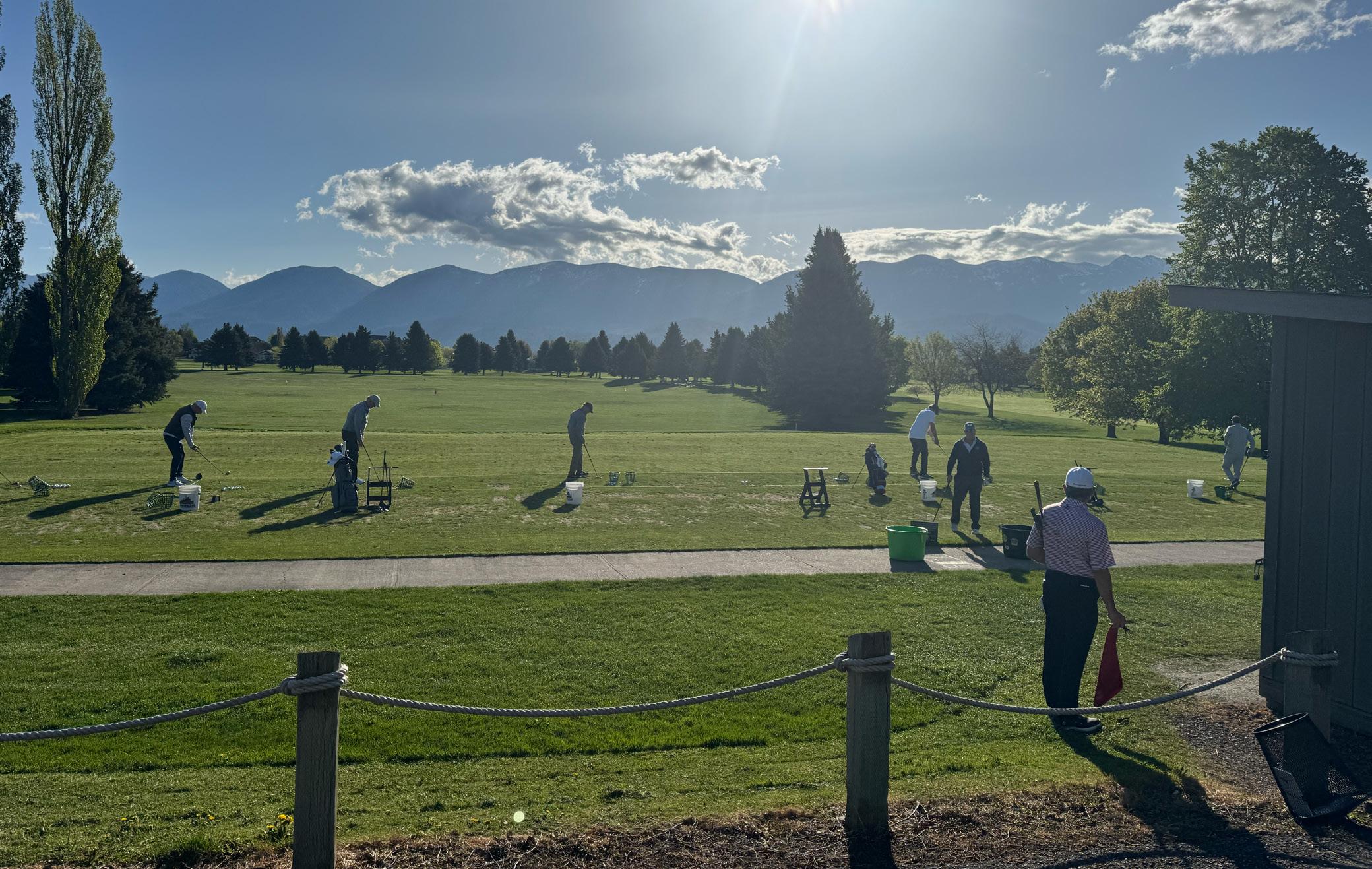
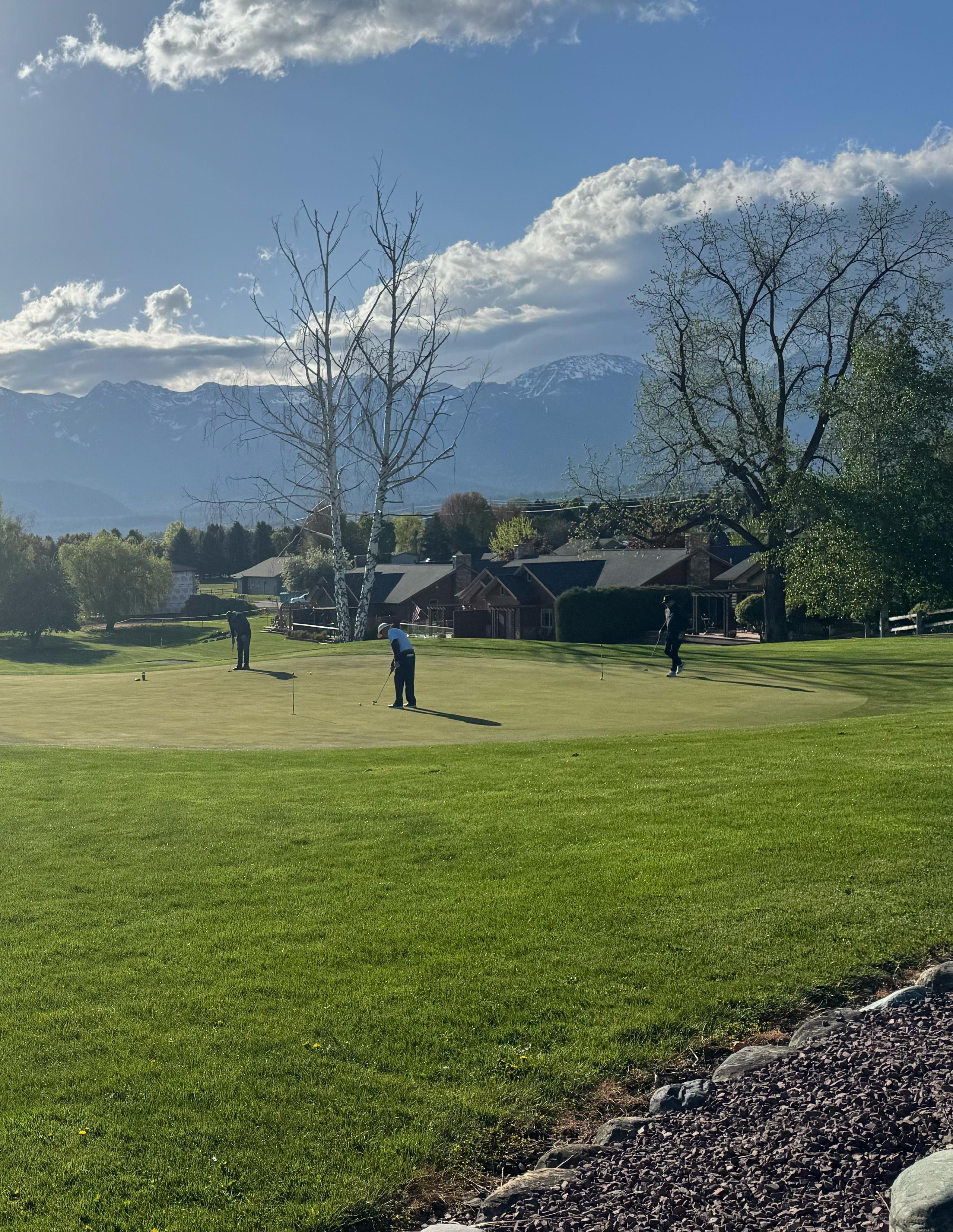
Q: What does the differential mean?
A: When you post your score, the score is converted into a Score Differential – this number accounts for the difficult of the course and tees you played (based on course rating and slope rating of those tees). The raw score on your card – say 92 from the middle tees at a difficult course may have a lower “differential” than an 84 from the front tees at a course with less challenging holes. Your differential means that you played like a golfer with a handicap of that figure during that round. So, your 92 with a differential of 18 means you played like an 18 handicap from those tees on that day. You may not be an 18 handicap (better or worse), but that’s a snapshot in time for that round.
Q: What is the difference between my handicap and my course handicap?
A: Your Handicap Index (HI) is the portable representation of your playing ability. You can travel from course to course and use your index to determine your Course Handicap (CH), which is the useful number you would use in a friendly competition for a tournament. You will see on the app that below the “post score” red button, there is the “handicap calculator.” From here, you can calculate how many shots your index translates to on a specific course from a specific set of tees. Depending on the difficulty of the course and tees, your CH may be more or less than your HI.
Clear as mud, right? From time to time, I’ll include a few questions from readers, but for now it’s those I’m seeing at the course. We will review more during the season. Wishing you a great start to the golf season, see you out there!

BOARD OF DIRECTORS - OFFICERS
PRESIDENT................................................... Peter Benson
VICE PRESIDENT.................................. Ron Ramsbacher
TREASURER....................................................... Bill Dunn
PAST PRESIDENT......................................... Mary Bryson
EXEC COMMITTEE......................................... Karen Rice
BOARD OF DIRECTORS
Brett Bennyhoff, Peter Benson, Carla Berg, Mary Bryson, Bill Dunn, Cheri Ellis, Lisa Forsberg, Marcia Hafner, Ron Ramsbacher, Karen Rice, Joe Rossman, Rod Stirling
Executive Director......................................... Nick Dietzen
Tournament Director...................................... Tim Bakker
Membership Operations Director............... Emily Hulsey
Member Services Coordinator......................... Ian Hulsey
Communications & Tournament Manager.... Katie Fagg
Communcations Coordinator.......................... Ty Sparing
Partnerships & Business Development.......... Jess Miller
USGA PJ Boatwright, Jr. Intern................. Jaideep Desai
USGA PJ Boatwright, Jr. Intern................ Dean Hendrix
USGA PJ Boatwright, Jr. Intern...................... Ella Prigge
Jess Miller.................................. 1 (800) 628-3752, ext. 5
406GOLF STAFF
Editor in Chief............................................... Nick Dietzen
Consulting Editor........................................ David Bataller
Senior Writer..................................................... Ty Sparing

Graphic Designer............................................... Katie Fagg Montana State Golf Association P.O. Box 4306
1 (800) 628-3752 www.msgagolf.org





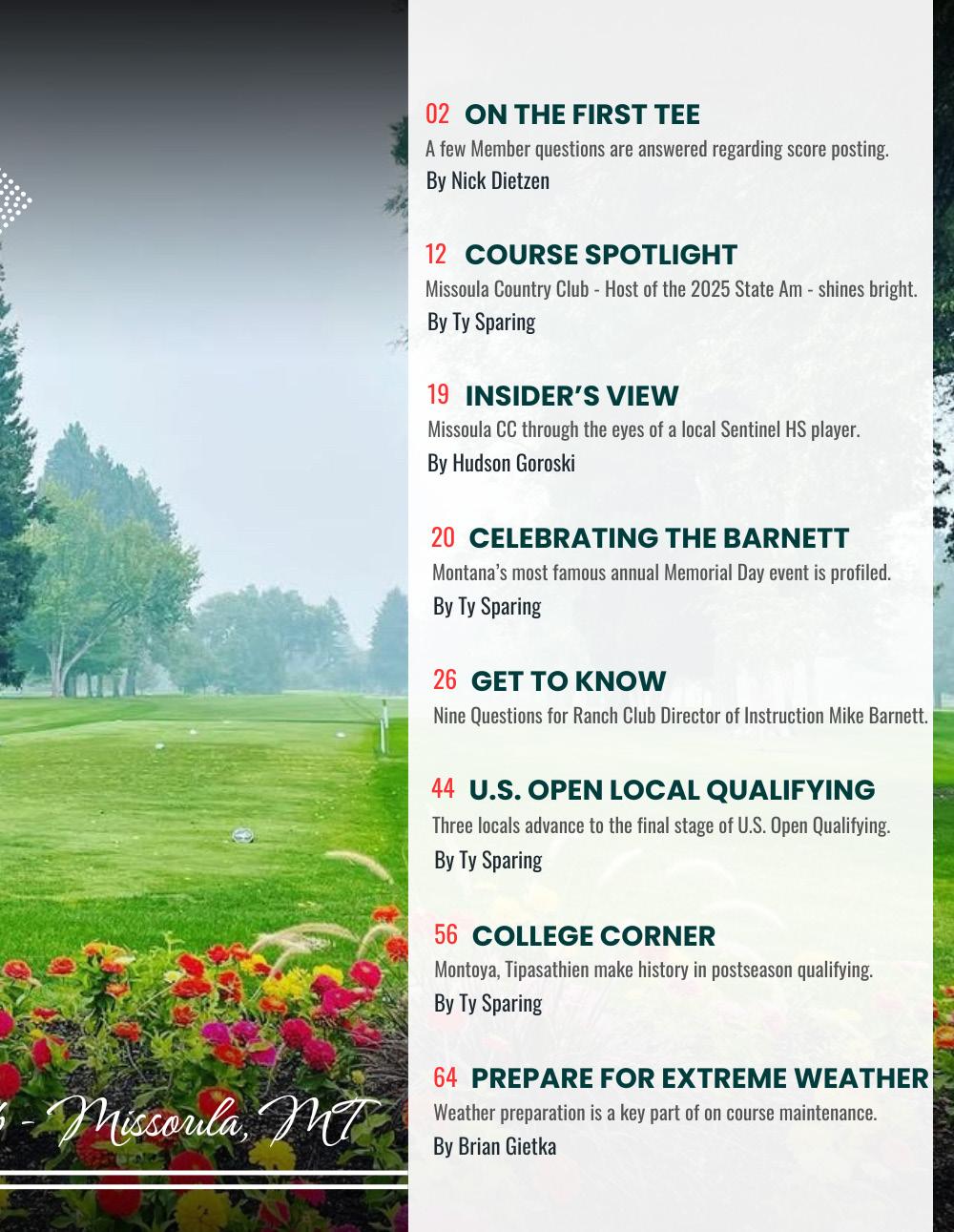


BY TY SPARING MSGA Communications Coordinator
Organized golf in Missoula goes all the way back to the year 1900, making it one of Montana’s foundational golf cities. Just one year after the construction of the Butte Country Club – the Treasure State’s first course – the original nine-hole Missoula Golf Club was built under Mount Sentinel between the University and the Missoula River (presently known as the Clark Fork River). The Butte Daily Post remarked shortly after it’s opening that the surroundings of the Missoula Golf Club “are endowed with nature’s greatest beauties and wonders in the way of farms, forest and covered mountains and streams.”
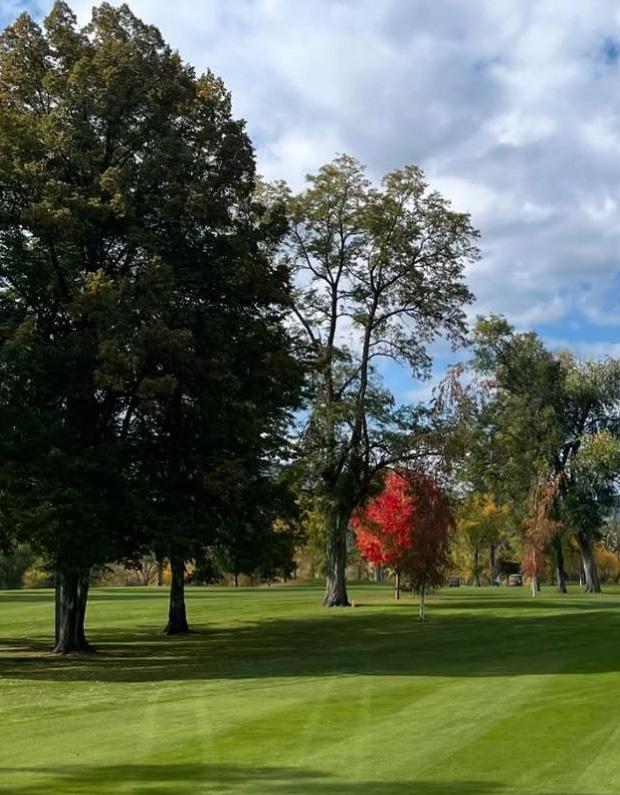
At this point in 1900 part of the uniqueness of the handful of Montana golf clubs that sprouted up around the state was that they were effectively introducing the sport to the region. Perhaps it’s understandable that even with a high-quality course like the Missoula Golf Club, it took a bit of time for the local population to get up to speed on the ins-andouts of the Royal & Ancient past time. For instance, when one local businessman was buying golf supplies for the first time, he tried ordering half a dozen caddies from the dealer. There was also much discussion amongst early members on what to call the playing grounds –links or course, with much of the links debate centering around the fact that it reminded people of sausage.


It wasn’t even golf that was considered the “most brilliant achievement in local golf circles,” that first year of the Missoula Golf Club. In fact, it was the story of a man who used a golf club to kill a goose that was on the course and ate it for Thanksgiving dinner. “The sporty tinge of the affair was lost” several days later when it was found out that the goose was part of a tame gaggle of geese owned by another citizen across the river.
Eventually though with practice makes perfect and before too long as the Anaconda Standard reported, Missoula golfers were “able to hit the ball without plowing up the earth for a space of three or four feet. This proficiency has only been acquired at the expense of much profanity.” No doubt many of us can relate.
With golfers making progress the very next year the Missoula Golf Club voted to change its name to the Missoula Golf and Country Club, although it proved short-lived as the course fell into disuse, leaving the Garden City without a golf location for nearly a decade.
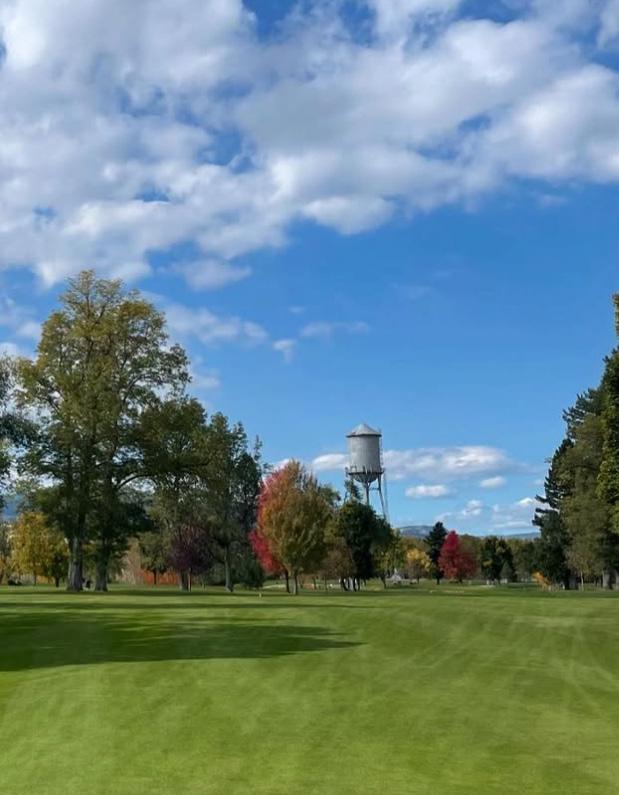
By 1906 people were once again clamoring for a proper course in Missoula, but that was still a few years out. What they did get, however, was the formation of the Bitter Root Valley Irrigation Company in 1909. The company took over from a previously failed canal building project between Missoula and Stevensville that was attempting to irrigate water out of the Lake Como Reservoir.
According to Jim Harmon, writing for the Missoula Current, the company aimed at providing a “new town in the valley,” and that it would “be a model place (named) Bitter Root.”
The original thought was that the Bitter Root Irrigation Company could make a profit by selling 10-acre orchard lots, and even commissioned Frank Lloyd Wright to build the Bitter Root Inn in anticipation that the area would become more densely populated. Among other items involved in these plans for new subdivisions near Missoula was the creation of the Sunnyside Golf Club.
Members at the short-lived Sunnyside

Golf Club were pretty good too as it happens, as they showcased in 1911 when they beat members from the Butte Country Club in a best of three match play series. As the Missoulian reported at the time, a Butte contingent traveled westward in what they thought was a courteous gesture after being extended an invitation from the Sunnyside members. The Butte golfers “expected that the game would be in the nature of a workout, as it was not supposed that there was anybody in the Bitter Root who could drive anything but a yoke of steers or putt anything but a rock on a stone fence.” It came as something of a surprise that the farmers in the Bitter Root could swing a club as well as they swung a scythe.
Although the Sunnyside Golf Club was not meant to last, many of its members became instrumental in the formation of the later Missoula Country Club. Fred T. Sterling and Hamilton Thatcher were two of those Bitter Root golfers that helped revive the sport with-

in Missoula city limits, although at first they attempted to purchase the Sunnyside course itself from the Bitter Root Valley Irrigation Company. Despite much initial enthusiasm in the spring of 1915, the Bitter Root Country Club never coalesced, likely due to the crumbling nature of the Bitter Root Valley Irrigation Company who filed for bankruptcy in January of 1916, in what was then called by local newspapers “the largest failure in [the] history of Montana.”
While 1916 marked the end of the Bitter Root Valley Irrigation Company, it was also the year that marked the official incorporation of the Missoula Country Club. Purchasing the Sunnyside links didn’t quite pan out, and after getting turned down by the U.S. War Department for a request to lease a portion of Fort Missoula for a new course, the Missoula Country Club finally found a home just south of the University campus.
Well, it was home for about nine years
and became notable for using sheep to mow the grass. A win-win type of situation as the Montana Record-Herald reported at the time that the purpose was “to add to the mutton and wool supply at the least expense, and to conserve labor.” However, by 1926 members of the Missoula Country Club voted to change locations, finally getting the go ahead from Fort Missoula to use their property. It was a necessary change for the sake of growth, as the Missoulian wrote that with the club “going to Fort Missoula, where Uncle Sam already has established irrigation facilities, the club believes that it will be able to construct a beautiful grass course.”
The new nine-hole Missoula Country Club indeed laid claim several years later to the first grass green in the state (*There’s a little debate here between Missoula CC and Glacier Park Lodge Golf Course). Designed and constructed in 1931 by Dr. Don Barnett, who is often referred to as Missoula’s “Father of Golf”, the grass green was a first step in the Missoula Country Club’s ascent in the state’s golf scene. Since those early days they’ve continued to provide one of the most innovative and beau-

tiful courses in Montana for nearly 100 years now.
Just a year later in 1932 the optometrist Don Barnett won the inaugural Memorial Day Tournament at the Missoula Country Club, an event that decades later in 1977 would be renamed the Barnett Memorial Championship in his honor. To this day it remains one of the most competitive golfing competitions in Montana.
Once firmly established at the Fort Missoula location, it didn’t take long for the talented Missoula Country Club players to prove their merit as some of the best golfers in the state. Don’s sister Grace won the Women’s State Amateur Championship six times between 1923 and 1935, a feat only eclipsed by one other female golfer in state history, the great Helen Tremper, another Missoula Country Club golfer who won the State Amateur a whopping fifteen times over a twenty-year span (1955 -1975).
On the men’s side, along with the talented Barnett, Missoula Country Club produced Pauly Sechena who won two State Men’s

Amateurs in 1941 and 1950. In 1941 Sechena carved into the Butte Country Club dynasty whose members had won 21 of the first 25 State Men’s Amateurs. He might’ve won more too during that decade of the 1940s if it wasn’t for World War 2. Instead of more golfing accolades under his belt Sechena took home a Silver Star for bravery instead. The next men’s golfer to win a State Amateur representing the Missoula Country Club was Don’s grandson Mike Barnett, who won back-to-back titles in 1974-1975.
In 1949 after several years of construction the Missoula Country Club finally expanded to 18 holes and promptly hosted their first of many state events. Young Edean Anderson, arguably the best golfer in Montana history, won her sixth straight Women’s Amateur title that year. The Missoula Country Club would go on to host the Women’s State Amateur eleven times, while this year will mark the thirteenth occasion that they have hosted the Men’s State Amateur.
Since it’s founding in 1916 the Missoula Country Club has been an integral part of the Garden City. If anything it’s more popular now in it’s 99th year than ever, having registered

over 10,000 rounds of golf in 2024, making it one of the most popular courses in the state. With nearly a century under its belt, there’s no sign of slowing down for one of Montana’s most foundational courses.
This year we are excited once again to gear up for what should be another fantastic Men’s State Amateur at the Missoula Country Club. For those planning on attending June 26-28, along with reveling in its rich history, golfers and spectators have a chance to get acquainted with one of Montana’s premier championship courses.
It’s not just the impeccable course conditions either that are impressive, as the Missoula Country Club has excellent facilities all around. The food alone is worth a trip over (see 406foodies). The first time eating there several years ago I had a grilled chicken sandwich for lunch that I couldn’t stop talking about for days! The course is impeccable, the food is delectable, and they have an exceptional staff on hand. It’s an easy place to enjoy!
Thanks to all those who have made the Missoula Country Club a special place all these years, and here’s to another 99 more!
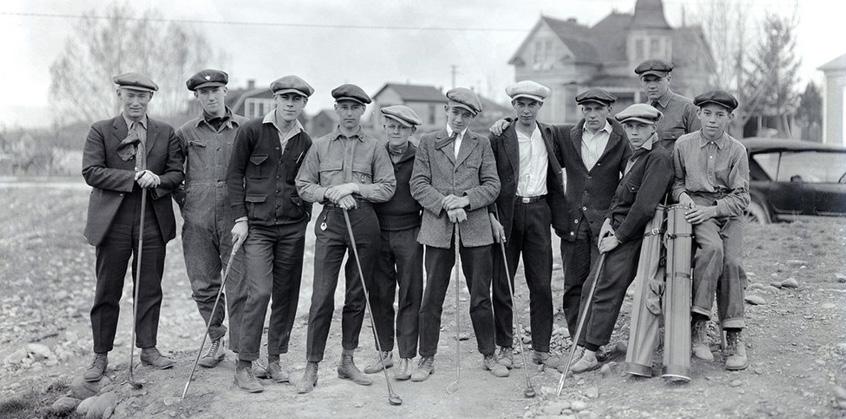
BY HUDSON GOROSKI MISSOULA-SENTINEL GOLFER
The Missoula Country Club is a tight old course that is always kept in great shape, as well as having some of the best practice facilities in the state. The course is always in fantastic condition, very pure, and the greens roll nice and fast.
I’d say the hardest and most unique hole is number three. It’s a dogleg right that you can layup on or go over the trees with a driver.

If the driver isn’t working, put it in the bag and use a club that will get you in the fairway. The course isn’t very long, but it’s very tight so being in the fairway is essential.
Besides golf, the pool at the Missoula Country Club is a great spot. When it’s too hot on a summer day, it’s a great place to relax, cool off, and have some food.
Overall, for me it’s been a great place to work and play. All of the members, employees, and golf pros are very welcoming and helpful.

BY TY SPARING MSGA Communications Coordinator
The last weekend in May will mark the 93rd year that the Missoula Country Club has hosted a Memorial Day golf tournament, one of Montana’s most competitive golfing events. Acting as the starter that weekend in 1932 was Dr. Lyman Barnett, the patriarch of one of the state’s ultimate golfing families. The victor of that inaugural Memorial Day Tournament was Lyman’s son, Dr. Don Barnett, a man many have called the “Father of Golf” in Montana, and the eventual namesake of the 54-hole competition.
Born in Wisconsin in 1868, Lyman Barnett moved the family to Glendive, Montana in 1910, then moved westwards once again, final-

ly settling in Missoula in 1914. Once established in the Garden City, the Barnetts became a force to be reckoned with in the Montana golf scene. Lyman himself was an astute golfer having become a senior champion at the Missoula Country Club and also served as the club’s President from 1922-1923.
Lyman’s interest in golf certainly rubbed off on two of his children, Don and Grace. By the time of that first Memorial Day Tournament in 1932, Grace had already won five of her eventual six Montana State Women’s Amateur titles and was runner-up twice.
Don meanwhile had also established himself as one of the Treasure State’s top golfers, showcased that very year when he won the Memorial Day Tournament in Missoula, the Glacier Park Labor Day Tournament, and was

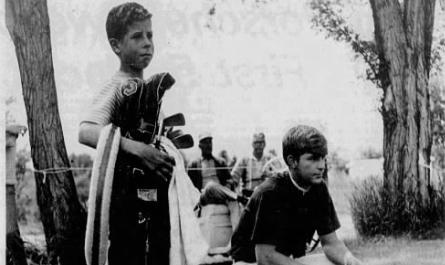
in the championship flight of the Montana State Amateur. Not only that, but he is credited with building the first grass green in Montana the year prior, currently known as Hole #16 at the Missoula Country Club. Along with being golf buddies with his dad, Don and Lyman ran their own Optometry practice, called the Barnett Optical Company.
As good of a golfer as Don was (Missoula CC club champion ten times), a big part of his legacy was his likability and his contributions to the sport in Montana. He helped organize the very first Montana State Amateur Championship in 1917 and was an absolute staple at the event, attending 45 of the first 50 State Amateurs. Barnett was notable for being the first entrant received every year. He also organized that initial Memorial Day tournament in 1932, helped organize countless other tournaments, served as President of the Montana State Golf Association, served on the board of directors, spent many years serving on the rules committee, was a volunteer coach at the University of Montana, and was active
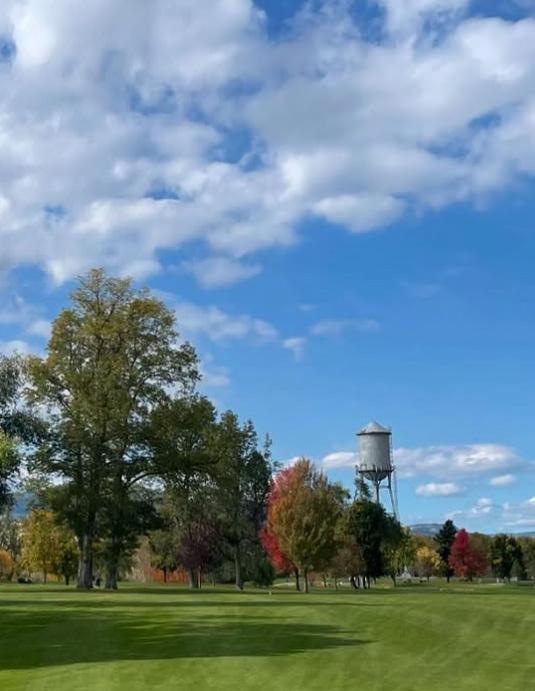
course, with either my dad, my grandad or my great-aunt-Gracie, who was one of the best senior women golfers in the state.” Not a bad crew of people to learn the game from, to say the least.
A prodigious young talent, it didn’t take long for Mike to cause waves in Montana golf circles. As an 11-year-old playing in his first State Amateur he brought adults to tears in what was then a Match Play style event. In 1967 at age 15 he was the runner-up at the Montana State Amateur, and in 1969 he broke a record on his way to winning the Memorial Day Tournament in Missoula. Among others that he defeated that Memorial Day weekend in 1969 was the defending champion, Dr. John Barnett. During this era Mike also captured three state high-school individual titles for Missoula Sentinel.
Mike later starred at Arizona State University and it was during those years that he won back-to-back Montana State Amateur Championships. His first title in 1974 Barnett broke
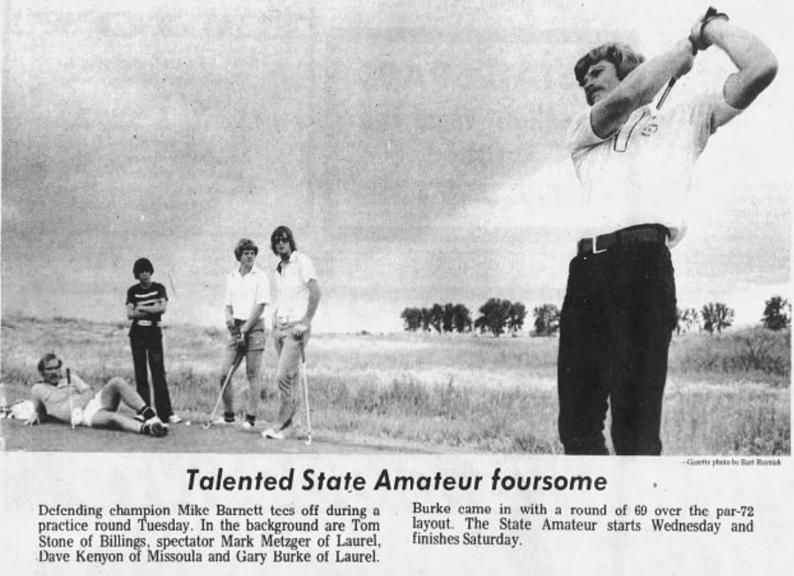
the 72-hole record by five strokes, and after Mike finished his putt on the final 18th hole, grandpa Don was there exclaiming “You’ve done it! You’ve done it!”
“I won it for you and dad,” Mike replied.
After college Mike would go on to play professionally for several years on the Australian and Asian tours before a back injury ended his touring career.
In 1967 the Montana State Golf Association renamed one of the awards given out at the State Amateur. What was formerly named the Merkle Cup, dating back to 1930 (after past MSGA President, Arthur Merkle), was rechristened the Barnett Cup in honor of Don’s contributions to the game of golf in Montana. The award is still given out annually to the top two-person teams from the same club who

shoot the lowest first 36-holes of the tournament.
After Don died in 1977, as a tribute to the man who meant so much to the Missoula Country Club, the prestigious tournament held there in late May was renamed the Barnett Memorial Golf Tournament. A fitting homage to the man who won the first Memorial Day event way back in 1932.
Then in the 1980s the whole clan of Barnett’s got their due when they were inducted into their respective Hall of Fames. First it was Don, John, and Mike who were amongst the 29 charter members of that very first class of MSGA Hall of Famers in 1986. Considering that the Montana State Golf Association was formed nearly seventy years prior in 1917, to have three generations of the same family get
inducted with only two dozen other Montana golf legends is astonishing. As one Missoulian article proclaimed, “the Barnetts of Missoula are rightfully considered as the foremost family of Montana golfdom…In many ways the three figures exemplified both service and success in Montana golf history.” Fittingly, since Don wasn’t around anymore to receive his award, it was sister Grace that accepted the plaque in his honor.
The next year it was Grace’s turn for a Hall of Fame induction, one of the first four women ever given the honor by the Montana State Women’s Golf Association (Helen Tremper, Jane Hibbard, Louis Knight are the others). At the age of 87 Grace was all smiles as she accepted her plaque at the Riverside Country

Club in Bozeman.
These days you might see Mike out at the Ranch Club, doing what Barnetts seem to do best – giving back to the golf community. As the Director of Instruction new generations are able to learn the game from one of the great golfers in Montana history.
As for the Barnett Memorial Tournament, it’s been almost fifty years since the name change, and it still remains one of Montana’s most signature golfing events of the year. If you happen to be out on the course whether playing, administering, or just observing, take a moment to reflect on Don Barnett and the impact he and his family have had on the game of golf in Montana.




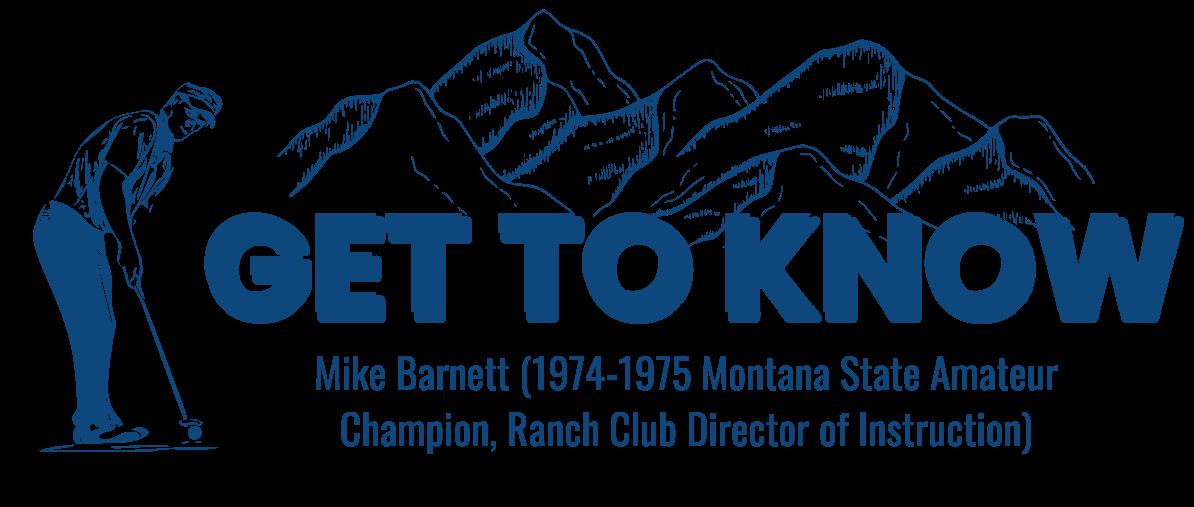
1. Who introduced you to golf?
My father, John, at age five when I was at an Easter egg hunt at the Missoula Country Club.
2. Who influenced you most in your golf life?
It was a group effort... My Dad, who was a 17-time MCC club champion, began teaching me and taking me out on the course at age 6. My grandfather, Don, a 10-time club champion at MCC; and my great Aunt Grace, who was a six-time Montana State Women's amateur champion, would take me out on the course every Tuesday morning in the summers. So I was an early recipient of all their knowledge and experience.
3. What are some favorite memories of winning back-to-back Montana State Amateur titles in 1974-1975? Considering your family golfing legacy in Montana, what was it like to win in front of your grandpa, Don, and dad, John?
In 74’ at Butte CC the first day I opened up with a very disappointing 38 on the front nine and gave myself a real kick in the butt shooting 29 on the back 9 for an opening round of 67. I had been a runner up at age 15 and age 20 and had dreamed about
winning for the entire year before the ‘74 Championship. I had visualized playing every hole and even visualized my acceptance speech. That 38 didn’t fit my dream!
I followed up with 67, 70, 68 and won by 9. After the final round I’ll never forget walking from the 18th green back to the clubhouse with my arm around Grandpa Don who congratulated me, told me how proud he was of me and shared with me he felt he had been “born again”! His comment makes me emotional even to this day. The following week I was back at Butte CC qualifying for the U.S. Amateur. I’m playing a hole and Evil Knievel is playing an adjoining fairway. He stops, takes the time to come over, shakes my hand and congratulates me! Needless to say I’m extremely flattered by his kind gesture. It just so happened his older son Kelly had been my caddy during the State Am.
The 1975 Montana State Am was played at Laurel CC. It was very important to me to follow up with another championship to justify my turning professional which I fortunately did.
4. What is your favorite course in Montana and why?
The Missoula Country Club of course! To this day I still love playing it. It’s so beauti-
ful with all its trees and flowers and typically in fantastic shape. It's truly a shot makers course. You need to draw it on some holes, you need to fade it on others, and there are holes you really benefit by hitting it straight! The greens in peak season have wonderful speed and are tricky if you're in the wrong position.
I’m proud to say my Grandfather Don was responsible for building the first grass green in Montana about 1931, I believe. He journeyed to Spokane, Wash. and met with the superintendent at Spokane CC and learned how they made their grass greens. Prior to that, Missoula CC members and guests putted on greens made of sand or cotton seeds.

5. What is a dream golf course you’d like to play once?
Augusta! Bobby Jones and Alister MacKenzie created a true masterpiece for all time!
6. What is your dream celebrity foursome (living or dead)? Why would you choose them?
Bobby Jones the greatest amateur of all time winning 13 major championships, first winner of the Grand Slam and creator of Augusta National and the Masters Golf Championship. The great Jack Nicklaus, who I have met, and winner of the most major championships of all time, and a true gentleman...and lastly Ben Hogan, 9-time
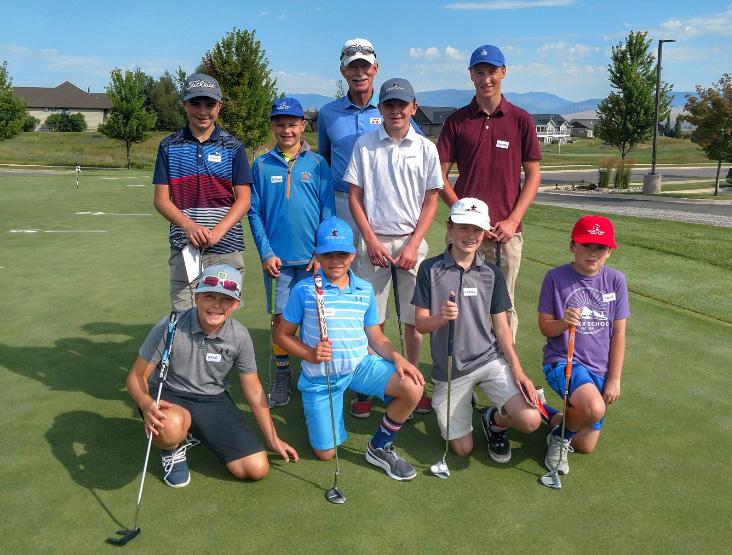
major champion who survived a near death car/bus accident and considered the greatest ball striker of all time.
7. What’s your most memorable moment on a golf course?
When my Grandfather Don had congratulated me after my first and Montana State Amateur victory telling me how proud he was of me and that he felt as if he had been born again!
8. If you could change one thing about the game of golf what would it be?
Make the game more affordable so many more families and kids could have access to the game. The incredible lessons to be learned on the golf course are many. It’s a place where kids can have fun while learning respect for others and the course, perseverance, sportsmanship, build confidence, how to deal with adversity and many more

values. The First Tee program should be part of every school’s curriculum. Through the game of golf kids have a great opportunity to develop the skills to become better citizens and human beings!
9. What advice would you give to beginner golfers?
Get some good help including professional instruction if it's in the budget. Golf is a challenging game but can be learned and enjoyed more with quality help. Contact a local golf course and ask for guidance as to how to best proceed!
Bonus memory?
One of my very fond memories in golf is having the opportunity to shoot a Visa/ Mastercard TV commercial with Jack Nicklaus in Scottsdale Arizona and getting a lesson from him between shoots! He was incredibly gracious and helpful!
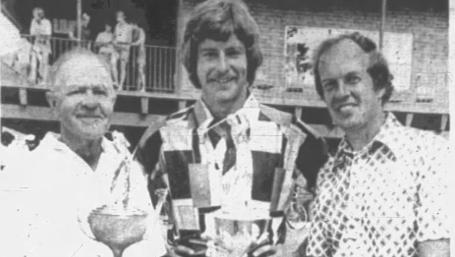


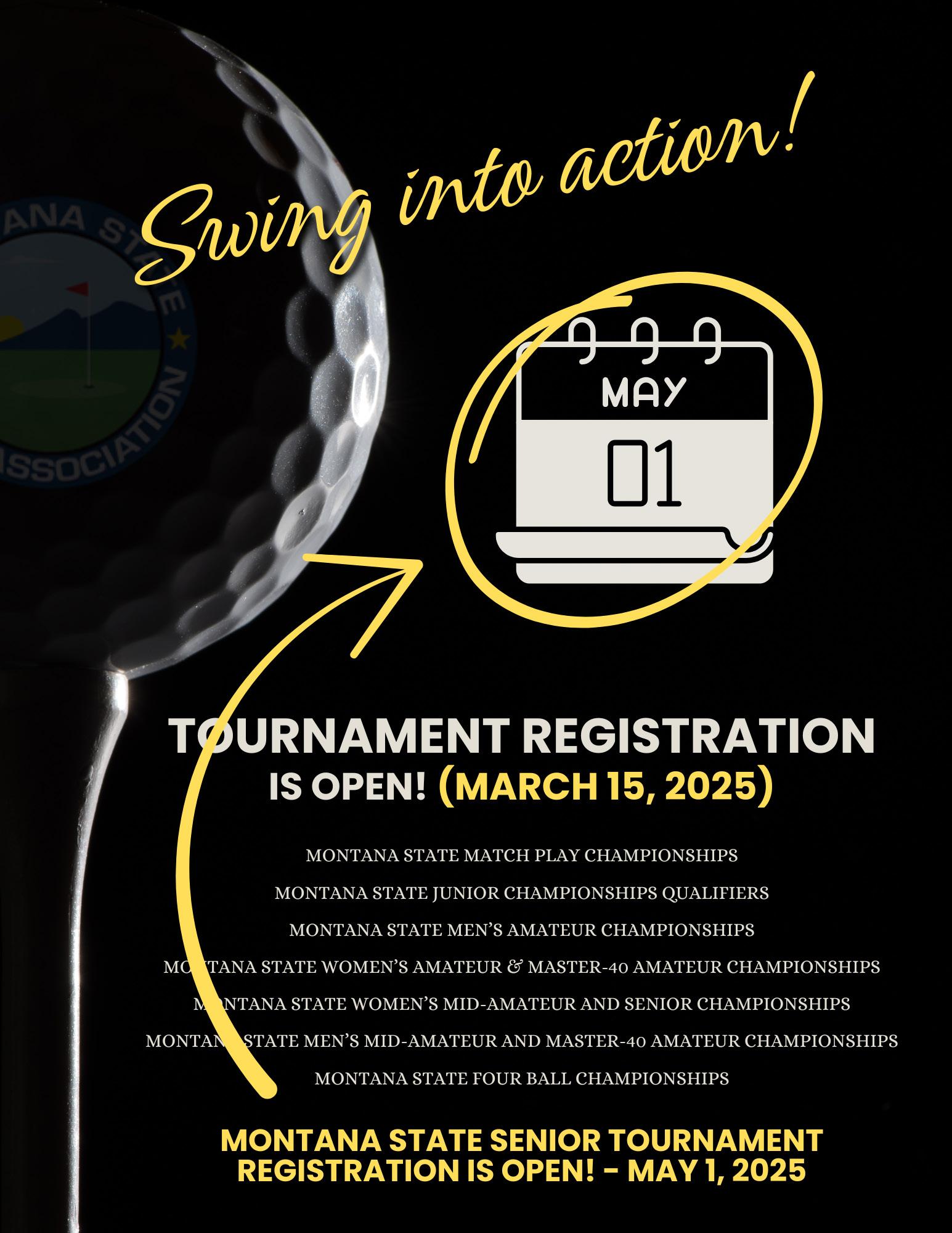


BY EMILY HULSEY MSGA MEMBERSHIP DIRECTOR
Free to all MSGA members, the GHIN app allows you to track hole-by-hole scores for everyone in your group. This tool can be used to create a fun game among friends!
In the GHIN app, select “Play with GPS/ Games”, choose the course, then choose either 1) Match Play - Net, 2) Match Play - Gross, or 3) Keep Score For Group.
Once the game is set up, add each player, then select the tees they will play. Finally, calculate their handicap strokes (if playing a net game).
Then, track your match. An easy-to-use digi-

tal scorecard tracks the match for your group.
And finally, transfer scores. When the round has finished, easily transfer scores to the players in your group. They can individually review in their accounts and approve for posting.
What if golfers do not have a digital profile or do not belong to a GHIN Association?
Those golfers can be added to a match or have their score kept, but unfortunately, transferred scores will only appear within the GHIN Mobile App. So if golfers were manually added or do not have access to the GHIN Mobile App, their scores will not be transferred.
Remember, the score keeper can take a screen shot of their scorecard and message or email the image to other golfers.









BY TY SPARING
MSGA COMMUNICATIONS COORDINATOR
The unofficial start of the spring tournament calendar kicked off in Polson recently with the 35th annual Lake City Open. Held at the Polson Bay Golf Course, the Lake City Open features professional and amateur divisions, both of which draw out some of the best golfers in the state and beyond. Golfers had two rounds of competition.
In the amateur division it was the reigning Montana State Mid-Amateur Champion, Sean Ramsbacher that took home the crown by just one stroke with a final two-round score of -9 (135). Ramsbacher’s tournament was highlighted by twelve recorded birdies over the two days and an eagle on the par-5 hole 18 during the first round. The former Montana Tech standout now has two Lake City Open titles to his name, the last coming in 2021.
Great Falls’ Ben Kaul finished up in second place in the Amateur division at -8 (136), followed by Nate Gage in third place at -6 (138) and a tie for fourth place between Colin

Jensen and Jason Welty who both ended up at -4 (140).
In the Pro Division Billings’ Garrett Woodin managed to edge out last year’s champion in Joey Moore by just one stroke. Woodin, who formerly played golf for the MSU-Billings Yellowjackets posted two rounds with zero bogeys, eleven birdies, and one eagle on the par-4 hole 16 during the second day of action. For his efforts Woodin earned $3,500.
Moore likewise had eleven birdies and one eagle (par-5 hole 18) to go with just one bogey during the tournament. The former San Diego State golfer earned $1,700 for his second place finish. Following Moore was a tie for third place between Dakotah Jenson and Ryan Malby who both finished up at -8 (136), while JW Scolari and Ryan Oliver tied for fifth place at -5 (139).
Malby was the Senior Pro division champion, followed by Mike Grob in second with an even par 144 and David Owens in third place after ending up at +2 (146).
For full results of the Lake City Open, CLICK HERE .


BY TY SPARING MSGA COMMUNICATIONS COORDINATOR
It was a cold and rainy day for golf at the Missoula Country Club as the Western Montana gem hosted a local qualifier for the 2025 U.S. Open. Three players from the 51-player field advanced to U.S. Open Final Qualifying. It was local Kade McDonough who earned medalist honors after carding a five-underpar 66. Also advancing was another decorated Montana golfer, Billings’ Joey Moore. Rounding out the qualifiers was Wisconsin’s Clayton Tribus who finished tied at the end of regulation at -4 (67).
McDonough, a two-time reigning Montana State Match Play Champion put together a bogey-free round that included five birdies en route to medalist honors. The former Missoula Sentinel standout and current Utah Ute had a back nine that pushed him over the top as he registered four birdies, including a clutch birdie putt on the 18th hole which gave him a one stroke victory avoiding a playoff when all was said and done.
With two more spots on the line, a threeman sudden death playoff included Missoula’s Jimmy Mee, Billings’ Joey Moore and Madison, Wisconsin’s Clayton Tribus. Montana golf fans certainly recognize Mee who is a Carroll College Hall of Fame golfer and current University of Montana head coach. Joey Moore who is competing as a profes -
sional is a two-time Montana State Amateur winner and former golfer at San Diego State University. Tribus meanwhile hails from Wisconsin, having spent one year competing for the Badgers after transferring from Davidson University.
Mee, who won the U.S. Open Qualifier in 2012 and qualified again in 2014, started off a little slower than he would’ve preferred sitting at +1 (36) over the first nine holes. On the back nine he caught fire with four straight birdies on holes 10-13 and then


added another one on hole 15. With a phenomenal back nine propelling him up the leaderboard, Mee found himself in a familiar position competing for the top spot.
Like Mee, Joey Moore is used to competing for medalist honors and his showing at this year’s U.S. Open Qualifier was more of the same. The former amateur star who turned pro after winning his second Montana State Amateur title in 2023, also won a U.S. Amateur Qualifier in 2021.
Tribus also kept mistakes to a minimum with only one bogey on the rain-soaked round, with five birdies (3, 4, 5, 7, 10). Having played the Missoula Country Club only once the day prior, Tribus’ ability to withstand the elements and land in one of the top spots was an impressive feat, even more considering the inclement weather.
It took two playoff holes to figure out the final two qualifying spots, although with a
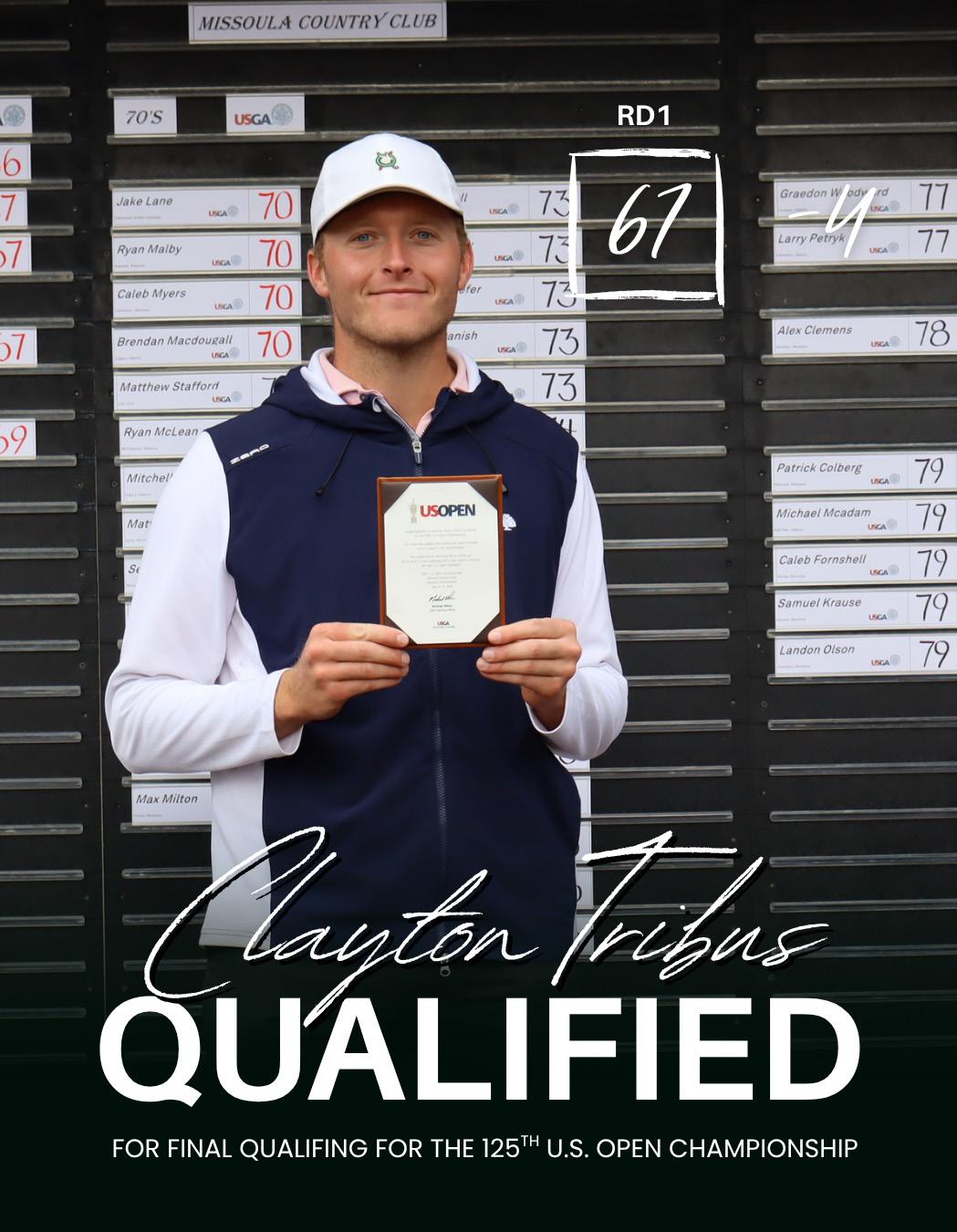
birdie on the first playoff hole Tribus secured his qualification while Mee and Moore parred and went on for another hole. After a Moore par and a Mee bogey on the par-4 eleventh hole, it was settled with Mee as the odd man out an earning alternate status.
McDonough, Tribus and Moore will move on to the final qualifying stage which will be a 36-hole format that will determine who will move on to the Oakmont Country Club in June for the 125th U.S. Open. In addition to Mee, Alberta’s Mike Valk will be an alternate.
There were 24 players from Montana who teed it up at Missoula Country Club, with other golfers coming in from all over the United States and Canada. The Missoula Country Club will be busy this year with high-level golfing events, as they will also host the 108th Montana State Men’s Amateur later this summer.

BY TY SPARING
MSGA COMMUNICATIONS COORDINATOR
After a brief respite back in Montana, Ryggs Johnston was back in action recently at the Turkish Airlines Open. Held at the Regnum Carya in Antalya, Turkey, it’s the first of several tournaments before Johnston will make his first appearance at the 153rd British Open in July.
Competing for part of the $2.75 million purse, Johnston played well with four rounds under par and ultimately finished in a tie for 33rd place at -7 (277) overall. His first

round of -3 (68) was the lowest of the tournament for Johnston, as he notched eight birdies that first day. He kept mistakes to a minimum over the ensuing rounds and even added an eagle during the third round on the par-5 fifteenth hole. He earned nearly $22,000 for his efforts and is currently in 27th place in the DP World Tour Race to Dubai Rankings.
For full results of the Turkish Airlines Open, CLICK HERE



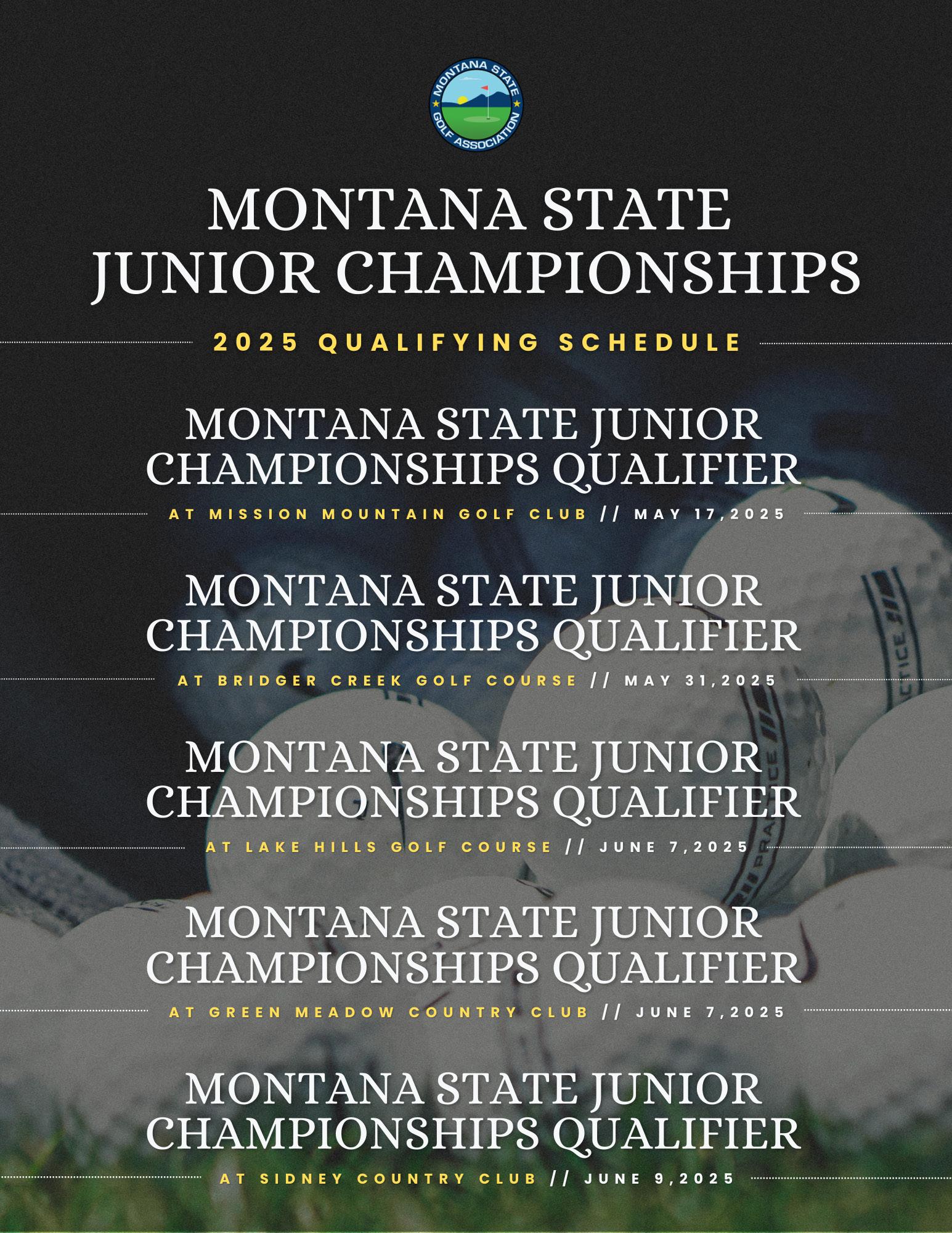

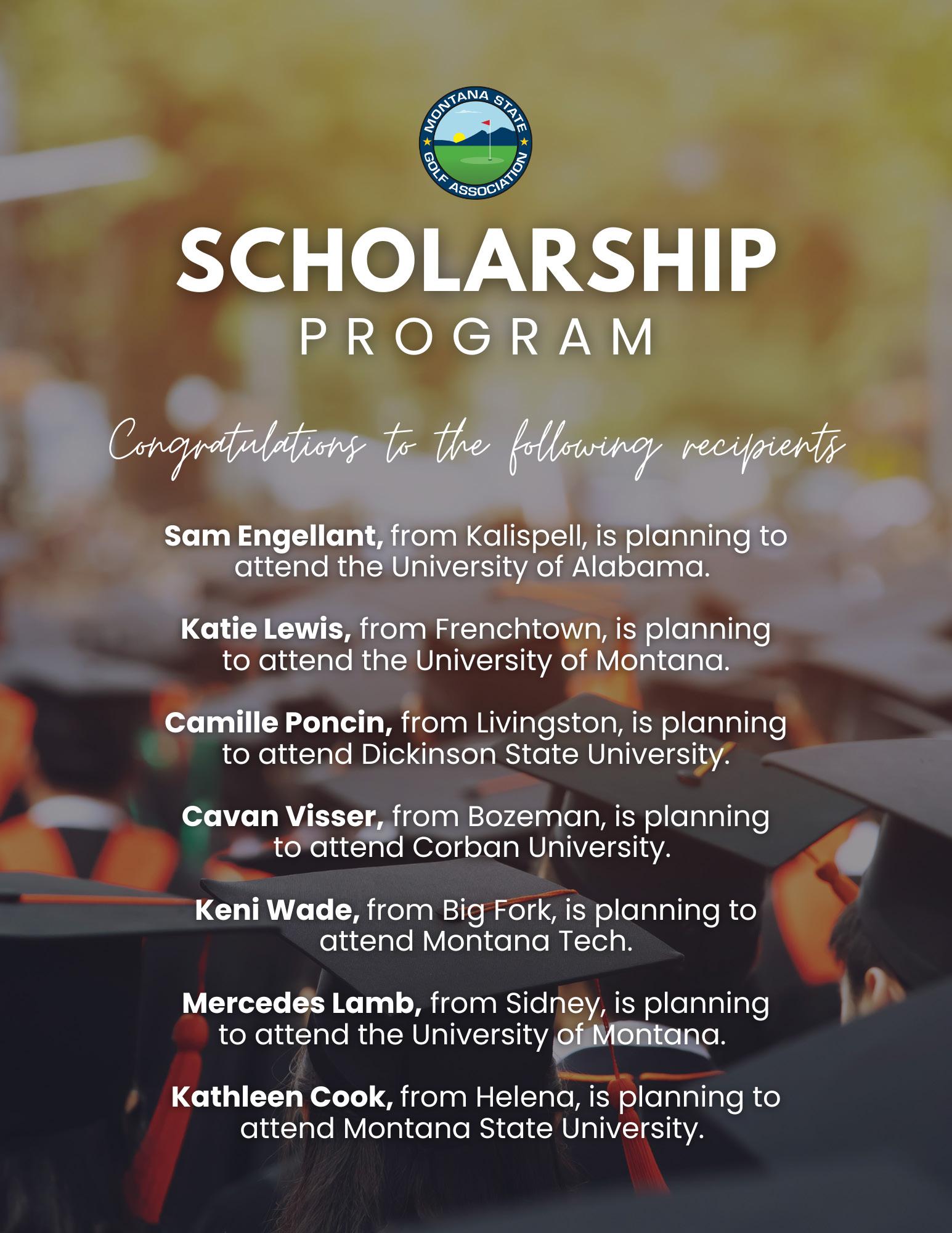


BY TY SPARING MSGA COMMUNICATIONS COORDINATOR
Class B golfers were at the beautiful Marias Valley Golf and Country Club in Shelby this year for the Class B State Tournament. Held May 13-14, some of Montana’s best young golfers competed under cloud cover in their final event of the season.

On the girls side it was all Florence-Carlton as they got off to a big early lead in round one and kept the foot on the gas through round two on their way to a 44 stroke victory at +184 (760). It was the first team victory for Florence-Carlton in program history, having finished in second place last year.
The Falcons also had the individual medalist in Kipley Solari who finished in first after two rounds at +21 (165). Coming into the second
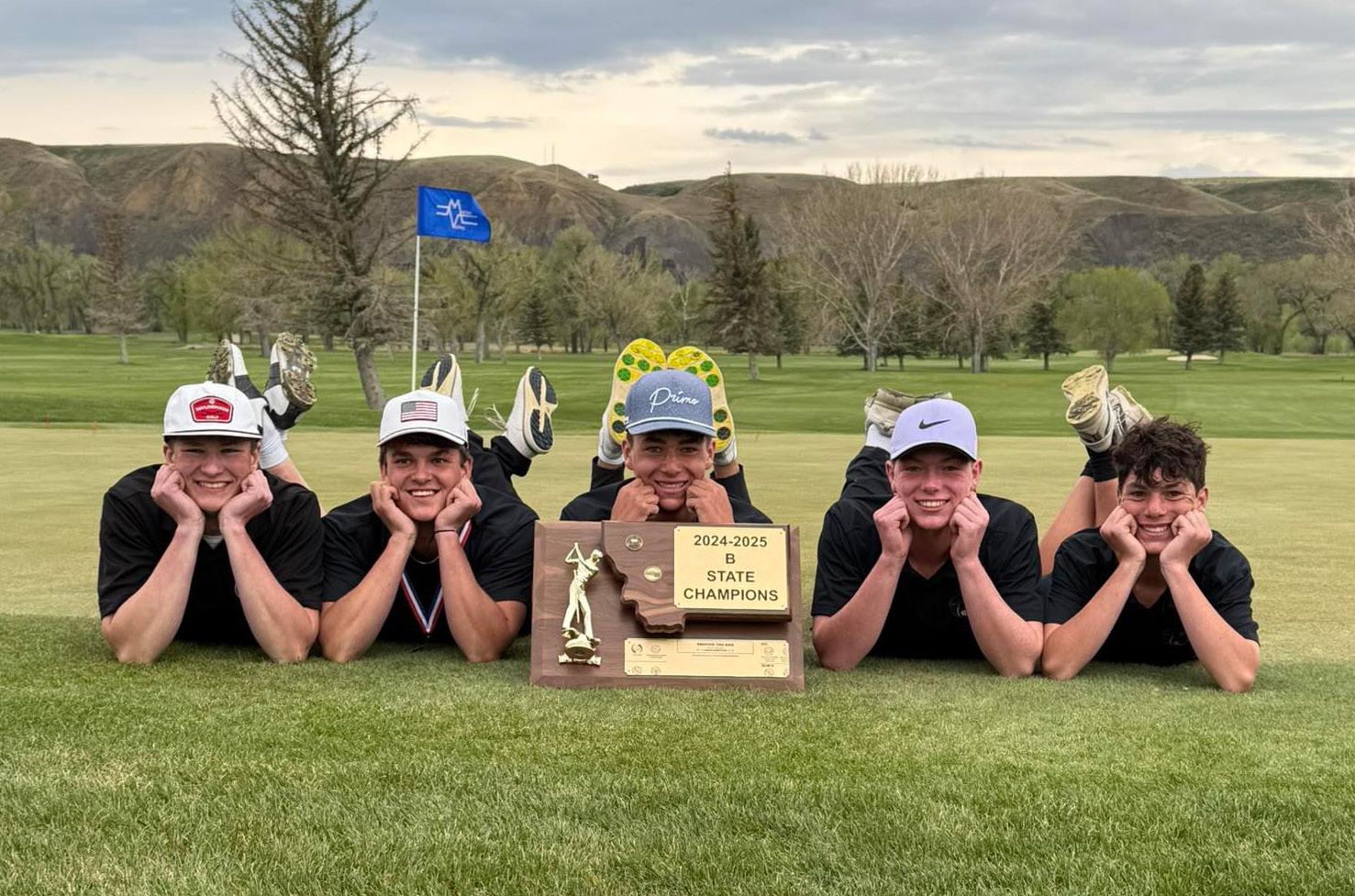
Charlton - MTN Sports

day in a tie for fifth place, Solari caught fire the second day and carded the best individual round of the tournament with a +5 (77). She was the only competitor to post a round in the 70s. With a birdie on the par-5 hole 4, Solari posted 12 pars which gave her enough for a comfortable four stroke victory. Solari was joined in the top ten by teammate Reese Briney who finished up at +41 (185). Briney also posted a birdie during the second round on the par-4 hole 5.
Following Solari in the top five was Anaconda’s Logan McKay in second place at +25

(169), Loyola’s Elise Munding in third at +26 (170), Lone Peak’s Dylan Manka in fourth at +29 (173), and Shelby’s Penelope Heaton finished in fifth place with a final score of +34 (178).
The boys individual competition came down to the very last hole, with Loyola’s Zach Munding sinking a clutch par putt for the one stroke victory over Jefferson’s Tyson Lee. Munding had three birdies on the round (holes 5, 15, 17) that helped erase a three stroke deficit. Over the two days Munding’s final score was +2 (146). Lee meanwhile finished up at +3 (147).

Joining Munding and Lee in the top five was a three-way tie for third place between Choteau’s Kellen Meyer, Huntley Project’s Griffin Zimmer, and Jefferson’s Ben Werner who all ended up at +10 (154).
With two players finishing up in the top five, it was Jefferson High that won their second straight boys team championship, with a final two-day score of +78 (654). They won by

twenty strokes over second place Three Forks who finished at +98 (674).
Congratulations to all Class B competitors on wrapping up another exciting season! For full results of the Class B State Tournament, CLICK HERE


BY TY SPARING
MSGA COMMUNICATIONS COORDINATOR
Maddie Montoya, Orraya Tipasathien Make National Postseason History
Montana State University’s Maddie Montoya and MSU-Billings’ Orraya Tipasathien both made history recently as the first golfers in their respective program histories to get invited to National Postseasons.
In Montoya’s case she had a thrilling run

through the Big Sky Conference Championships, posting three rounds under par en route to a title victory. A week later the junior from Boise was watching the Golf Channel with her teammates when she found out she’d be traveling back to Arizona to compete in the NCAA Gold Canyon Regional. In a program like Montana State with a past littered with talent, Montoya now has a special place in the record books as the first golfer in Bobcat history to qualify for the NCAA postseason.
Held May 5-7 at the Superstition Mountain Golf and Country Club, the Gold Canyon

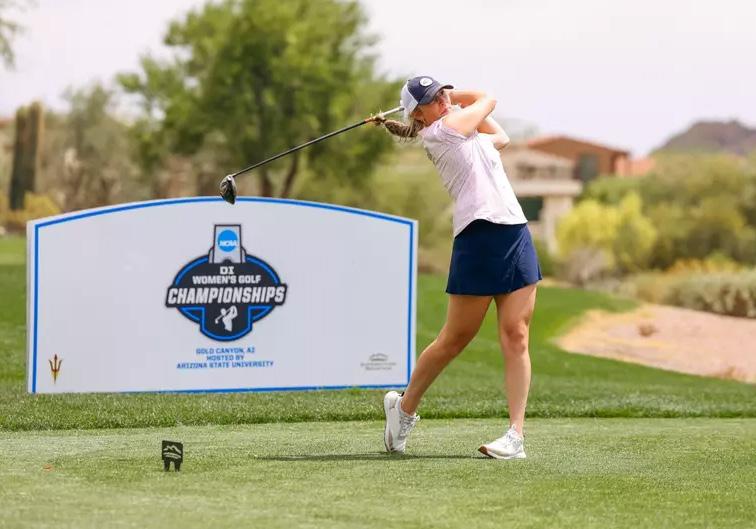
Regional hosted 70 of the top golfers in the nation, ten of whom came in ranked in the top 50. With nerves no doubt sky high, Montoya struggled a bit in the first round with score of +10 (82) before settling down in the second round, reducing mistakes and recording her first birdie of the tournament on the par-4 hole 11.
It was the third day that truly showcased Montoya’s elite talent after she posted a -1 (71), which would’ve tied for the sixth best round of the day. Helped by three birdies in her first nine holes, Montoya traversed up the leaderboard to finish in a tie for 48th place overall at +14 (230). After not recording a round under par all season until the Big Sky Conference Championship when she did it three days in a row, it’s only fitting that she collected her fourth round under par during the last round

of the last event of the season. It’ll be exciting to see her come back as a senior and defend the crown next season!
For full results of the NCAA Gold Canyon Regional, CLICK HERE
Orraya Tipasathien had a slightly different path to the NCAA West Region Championships, qualifying for one of six at-large bids after a wildly triumphant year that saw the sophomore golfer from Thailand set a single-season Yellowjacket record with five consecutive individual victories. Not only was it the single season record but also tied a program record for most in a career. Assuming she comes back for two more years, Tipasathien has a chance to put MSU-Billings records out of reach for a long time.

MSU-Billings standout Orraya Tipasathien qualified for the NCAA West Region Championships by earning one of six at-large bids after a sophomore season that saw the Thailand-native set a single-season Yellowjacket record with five consecutive individual victories.
Given her extreme success this year in the D2 realm, Tipasathien was selected to compete in the West Region Championships. Also held May 5-7, the MSU-B star had three rounds of play against 110 other talented golfers at the Tascosa Golf Club in Amarillo, Texas.
Tipasathien came out early and despite thunderstorms throughout the day she established positioning in the top quarter of the field with a first round score of +7 (78). Coming into round two sitting in 23rd place, she went out and shot +2 (73), which included three birdies.
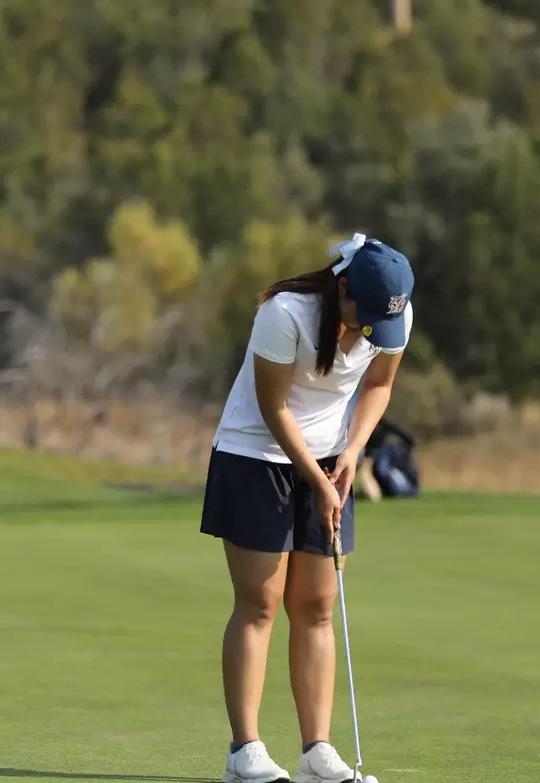
Day three Tipasathien came into the round and recorded a +8 (79), giving her a final cumulative three-round score of +17 (230). It tied her personal best 54-hole score and put her in a tie for 55th place when all was said and done.
After an historic season in just her sophomore year, Tipasathien will come back to her junior year looking to build on her accomplishments and hopefully make it back to the national stage once again.
For full results of the D2 NCAA West Regional, CLICK HERE .





BY BRIAN GIETKA USGA AGRONOMIST - EAST REGION
A microburst is defined by Merriam-Webster’s Dictionary as “an intense, localized downdraft of air that spreads on the ground, causing rapid changes in wind direction and speed.” I have witnessed the aftermath of a microburst, and the best comparison I can think of is the destruction of a wide tornado. In June of 2024, an intense weather event ravaged a central Pennsylvania golf course during the early evening with golfers still on the course. This microburst left over 320 mature trees on the ground or ripped apart.
More recently, in April a line of intense storms with over 75 mph winds left destruction

in Maryland. Well over 100 trees were uprooted or twisted off, fences were pulled over, trees landed on cars and there was no electricity for days. This was a completely unexpected event and has been a test of preparedness. In fact, strong storms just hit the Pittsburgh area during preparations for the U.S. Open at Oakmont.
Generally, hurricanes and tropical storms are predicted well before they make landfall, giving residents and golf courses some time to prepare. On the contrary, these microburst-type storms form intensely and quickly with little warning, which means you need to have a plan in advance in case one strikes your course. There are lots of ways you can prepare.
Having a list of employee and golf course officials’ contact information and knowing utility



shut-off locations are top priorities. When the devastation is significant, knowing the course’s insurance provider is important to sort out policy details.
Hiring a local land clearing company may be more efficient than your regular certified arborist if many trees and limbs are down as land clearing companies are equipped to quickly finish felling trees, move them off-site and grind debris. There are benefits to both types of tree care companies in the aftermath of a severe storm – one for the heavy hauling and the other for dealing with partially damaged trees that need precise pruning.
In your turf facility, always ensure chain saws are sharp and ready to go, and portable fuel

cans are stored full. Electricity may be out for days, so know what size of portable generator is needed as well as the best connection method to power your irrigation pump station if a devastating event occurs. Assess the property for staff safety prior to beginning any cleanup work, and nobody should be on the course alone.
Take photos of everything and keep track of all in-house labor, repair supplies, contractor costs and rentals that are part of the cleanup effort – these figures will be added to lost revenues for insurance. Reach out to your regional USGA agronomist to assist with course recovery and tree damage evaluation. Unfortunately, this agronomist has been through it more than once.
Click Here for more from the USGA Green Section Record ‒including the latest articles and videos on sustainable management practices that produce better playing conditions for better golf.


